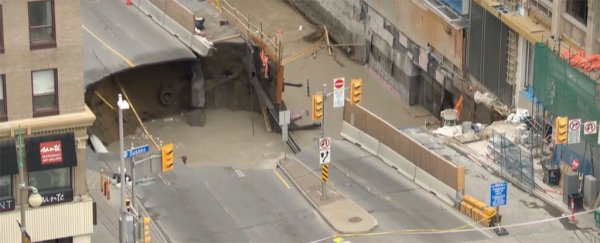A massive sinkhole has opened up in the heart of the Canadian capital Ottawa, taking out a major road and sending city officials into a panic. While the phenomenon destroyed part of the four-lane street and swallowed a parked van and lamp post, luckily, nobody was injured.
The sinkhole formed at about 10:30am ET on Wednesday in downtown Ottawa, beside a light rail construction site and close to a popular shopping mall. The incident caused a gas leak and power outages, and businesses close to the sinkhole were quickly evacuated, including the mall, a nearby hotel, and convention centre.
It's unclear what exactly caused the sinkhole, but city officials are scrambling to figure it out – as well as how to deal with the calamity just weeks before Ottawa hosts world leaders including the US and Mexican presidents at the 'Three Amigos' summit.
"We hope to have that answer, obviously, in the next few days," Ottawa Mayor Jim Watson told the press at an emergency meeting of city officials. "We just don't know how long it's going to take… it's a significant sinkhole in the downtown core."
While an official explanation is not yet available, the sinkhole – which is expected to disrupt the local area for weeks or even months – might have been caused by activity at the light rail construction site directly beside the hole. The new light rail transit (LRT) is a major new piece of infrastructure in the city, though it's not clear how the sinkhole will affect the plans.
"It's premature at this point to make the connection to LRT, although that could very well be the possibility," Watson told the media. "No city wants to see this kind of a sinkhole, but I can tell you that if you look back in the last year, there was probably a major sinkhole in every city, at least once a week somewhere in North America or around the world that's on the nightly news, and we're one more."
In addition to the light rail, the Rideau Centre - the nearby shopping complex - has also been undergoing extensive renovations, so officials are also looking into its potential role in spsurring on the sinkhole.
On the other hand, it could be that things going on below the surface are to blame.
Much of the soil underneath the city is Leda clay - also known as 'quick clay' - and the sensitivity of this clay has led to numerous landslides in the region, including an event in 1908 that claimed 34 lives, Bryson Masse reports for Motherboard.
Some 10,000 years ago, parts of Ontario and Quebec flooded due to overflows of the Champlain Sea, stemming from glacier melt after the last Ice Age. These waters left a layer of quick clay over much of the Ottawa region, and it's possible that this sensitive soil is linked to the formation of the new sinkhole.
"It is a geologic issue," geologist Peter Bobrowsky from the Geological Survey of Canada told Motherboard. "If we didn't have sand and gravel there, if it would have been the good Pre-Cambrian bedrock, you wouldn't be getting any kind of sinkholes. The geology plays a huge role."
We won't know more for sure until Ottawa officials have a chance to examine the phenomenon, but in the meantime, you can see footage of the sinkhole in the videos below.
